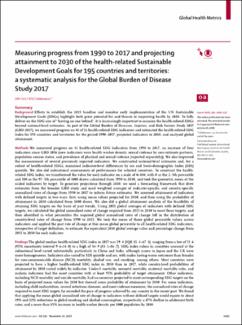Measuring progress from 1990 to 2017 and projecting attainment to 2030 of the health-related Sustainable Development Goals for 195 countries and territories: a systematic analysis for the Global Burden of Disease Study 2017
Date
2018-11-10Author
Lozano, Rafael
Fullman, Nancy
Abate, Degu
Abay, Solomon M
Abbafati, Cristiana
Abbasi, Nooshin
Abbastabar, Hedayat
Abd-Allah, Foad
Abdela, Jemal
Abdelalim, Ahmed
Abdel-Rahman, Omar
Abdi, Alireza
Abdollahpour, Ibrahim
Suliankatchi Abdulkader, Rizwan
Dereje Abebe, Nebiyu
Abebe, Zegeye
Negesse Abejie, Ayenew
Abera, Semaw F
Zewdie Abil, Olifan
Aboyans, Victor
Abraha, Haftom Niguse
Abrham, Aklilu Roba
Abu-Raddad, Laith Jamal
Abu-Rmeileh, Niveen Me
Abyu, Gebre Y
Kokou Accrombessi, Manfred Mario
Acharya, Dilaram
Acharya, Pawan
Adamu, Abdu A
Adebayo, Oladimeji M
Adedeji, Isaac Akinkunmi
Adedoyin, Rufus Adesoji
Adekanmbi, Victor
Adetokunboh, Olatunji O
Adhena, Beyene Meressa
Adhikari, Tara Ballav
Adib, Mina G
Kouablan Adou, Arsène
Adsuar, Jose C
Afarideh, Mohsen
Afshari, Mahdi
Afshin, Ashkan
Agarwal, Gina
Aghayan, Sargis Aghasi
Agius, Dominic
Agrawal, Anurag
Agrawal, Sutapa
Ahmadi, Alireza
Ahmadi, Mehdi
Ahmadieh, Hamid
Ahmed, Muktar Beshir
Ahmed, Sayem
Yihunie Akalu, Temesgen
Akanda, Ali S
Akbari, Mohammad Esmaeil
Akibu, Mohammed
Akinyemi, Rufus Olusola
Akinyemiju, Tomi
Akseer, Nadia
Alahdab, Fares
Al-Aly, Ziyad
Alam, Khurshid
Alam, Tahiya
Albujeer, Ammar
Alebel, Animut
Alene, Kefyalew Addis
Al-Eyadhy, Ayman
Alhabib, Samia
Ali, Raghib
Alijanzadeh, Mehran
Alizadeh-Navaei, Reza
Aljunid, Syed Mohamed
Alkerwi, Ala'a
Alla, François
Allebeck, Peter
Allen, Christine A
Almasi, Ali
Al-Maskari, Fatma
Al-Mekhlafi, Hesham M
Alonso, Jordi
Al-Raddadi, Rajaa M
Alsharif, Ubai
Altirkawi, Khalid
Alvis-Guzman, Nelson
Amare, Azmeraw T
Amenu, Kebede
Amini, Erfan
Ammar, Walid
Anber, Nahla Hamed
Anderson, Jason A
Andrei, Catalina Liliana
Androudi, Sofia
Animut, Megbaru Debalkie
Anjomshoa, Mina
Ansari, Hossein
Ansariadi, Ansariadi
Geleto Ansha, Mustafa
T Antonio, Carl Abelardo
Anwari, Palwasha
Appiah, Lambert Tetteh
Aremu, Olatunde
Abera Areri, Habtamu
Ärnlöv, Johan
Arora, Monika
Aryal, Krishna K
Asayesh, Hamid
Asfaw, Ephrem Tsegay
Weldegebreal Asgedom, Solomon
Asghar, Rana Jawad
Assadi, Reza
Ataro, Zerihun
Atique, Suleman
Atre, Sachin R
Atteraya, Madhu Sudhan
Ausloos, Marcel
Avila-Burgos, Leticia
Avokpaho, Euripide FGA
Awasthi, Ashish
Ayala Quintanilla, Beatriz Paulina
Ayele, Henok Tadesse
Ayele, Yohanes
Ayer, Rakesh
Azarpazhooh, Mahmoud Reza
Azzopardi, Peter S
Azzopardi-Muscat, Natasha
Babalola, Tesleem Kayode
Babazadeh, Arefeh
Badali, Hamid
Badawi, Alaa
Balakrishnan, Kalpana
Bali, Ayele Geleto
Banach, Maciej
Banerjee, Amitava
Mattar Banoub, Joseph Adel
Banstola, Amrit
Barac, Aleksandra
Barboza, Miguel A
Barker-Collo, Suzanne Lyn
Bärnighausen, Till Winfried
Barrero, Lope H
Barthelemy, Celine M
Bassat, Quique
Basu, Arindam
Basu, Sanjay
Battista, Robert J
Baune, Bernhard T
Wondifraw Baynes, Habtamu
Bazargan-Hejazi, Shahrzad
Bedi, Neeraj
Beghi, Ettore
Metadata
Show full item recordAbstract
Background Efforts to establish the 2015 baseline and monitor early implementation of the UN Sustainable Development Goals (SDGs) highlight both great potential for and threats to improving health by 2030. To fully deliver on the SDG aim of “leaving no one behind”, it is increasingly important to examine the health-related SDGs beyond national-level estimates. As part of the Global Burden of Diseases, Injuries, and Risk Factors Study 2017 (GBD 2017), we measured progress on 41 of 52 health-related SDG indicators and estimated the health-related SDG index for 195 countries and territories for the period 1990–2017, projected indicators to 2030, and analysed global attainment. Methods We measured progress on 41 health-related SDG indicators from 1990 to 2017, an increase of four indicators since GBD 2016 (new indicators were health worker density, sexual violence by non-intimate partners, population census status, and prevalence of physical and sexual violence [reported separately]). We also improved the measurement of several previously reported indicators. We constructed national-level estimates and, for a subset of health-related SDGs, examined indicator-level differences by sex and Socio-demographic Index (SDI) quintile. We also did subnational assessments of performance for selected countries. To construct the health-related SDG index, we transformed the value for each indicator on a scale of 0–100, with 0 as the 2·5th percentile and 100 as the 97·5th percentile of 1000 draws calculated from 1990 to 2030, and took the geometric mean of the scaled indicators by target. To generate projections through 2030, we used a forecasting framework that drew estimates from the broader GBD study and used weighted averages of indicator-specific and country-specific annualised rates of change from 1990 to 2017 to inform future estimates. We assessed attainment of indicators with defined targets in two ways: first, using mean values projected for 2030, and then using the probability of attainment in 2030 calculated from 1000 draws. We also did a global attainment analysis of the feasibility of attaining SDG targets on the basis of past trends. Using 2015 global averages of indicators with defined SDG targets, we calculated the global annualised rates of change required from 2015 to 2030 to meet these targets, and then identified in what percentiles the required global annualised rates of change fell in the distribution of country-level rates of change from 1990 to 2015. We took the mean of these global percentile values across indicators and applied the past rate of change at this mean global percentile to all health-related SDG indicators, irrespective of target definition, to estimate the equivalent 2030 global average value and percentage change from 2015 to 2030 for each indicator.

